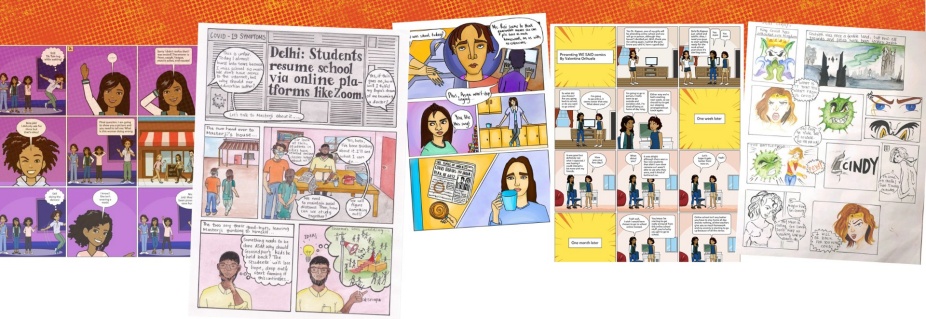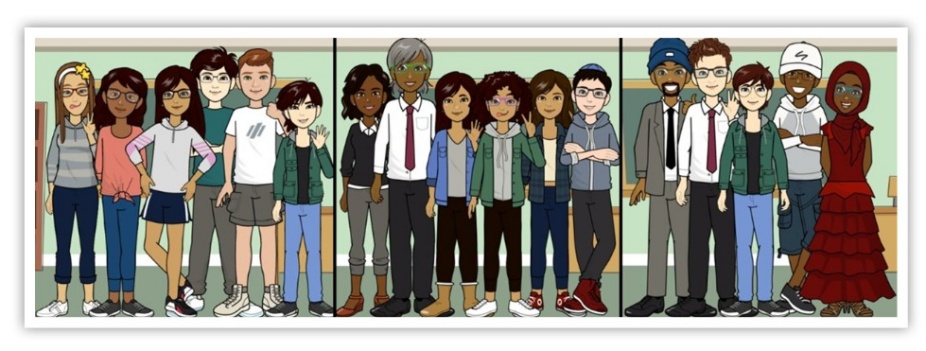
Students around the world come together to create COVID-themed comics with UB program
BY MARCENE ROBINSON
A team of UB GSE researchers helped high school students from the U.S., India and Mexico create comic book stories and better understand the pandemic’s impact on people and their communities.
The program, “Working for Educational-Equity: Scientists, Artists and International Design,” or “We Said” for short, brought together students on video calls to discuss how the COVID-19 virus was affecting people’s lives as they designed graphic novels in a free, three-week program last July.
The students’ stories, now on the We Said website, explored how wealth and access to health care shaped people’s experiences in different communities.
“Storytelling is a pathway to learning,” said program coordinator Sameer Honwad, GSE assistant professor of learning and instruction.
A lot of cultures around the world, particularly non-Western cultures, use stories as a platform to think about and understand the complexities in our world.”
The comic format works well for educators because it easily engages young people, he said. Over the past decade, graphic novels have become one of the fastest-growing categories in public libraries and other educational settings in the U.S.
“It’s an accessible art form that many of us grew up looking at, and the illustrations enable another layer of creativity and expression,” said Shakuntala Devi Gopal, a GSE doctoral student who coordinated the program. The COVID comic project team also included Ryan Rish, GSE assistant professor of learning and instruction, Jessica Scates, coordinator of diversity initiatives within the UB School of Dental Medicine, and Anthony White; GSE research assistant and adjunct instructor.

Building connections with stories
Honwad developed the comic project by drawing on his research interests—creating inclusive learning environments with storytelling platforms.
He initially designed “We Said” for a Buffalo high school to use graphic novels and explore local food systems. As the pandemic unfolded, he shifted online with a new focus on COVID-19’s community impact.
Honwad found 14 students interested in meeting on Zoom and making comic stories by reaching out to university contacts in the U.S., India and Mexico.
As the group began meeting, they focusing on the pandemic and the news of the past year, discussing the racial justice protests, technology and how people’s experiences differed, depending on socio-economic factors and resources, like wealth and health care access.
They also learned about each other and differences in their cultures. Students from the U.S. and Mexico were shocked that India had a caste system, Honwad said.
“There are a lot of similarities in how powerful individuals oppress people who have lower economic status. In the U.S. people are oppressed on the basis of race while in India the caste system is the basis for systemic oppression. In India the Dalits are members of society who were considered outcasts and continue to be left out of the socio-political conversations in contemporary India," said Honwad, who has been thinking about fostering more student conversations about the impact of colonialism. “How do you build solidarity between people who are in parallel situations in terms of oppression across the world?”
As the students developed their COVID stories, Rish, guest speakers and comic artists offered design guidance.
Eventually, the young people divided into groups that focused on a virus-related area: home life, school or relationships.
“The students enjoyed connecting with people in their age group that they would not have met otherwise,” Gopal said. “The experience also allowed them to work creatively. Some of the students don’t have opportunities for that type of expression.”
Next up: The researchers plan to apply for grant funding to expand the project and train teachers to help students design comics as part of their lessons. “How can teachers use storytelling as a tool,” Honwad said, “to get their own material across to students?”